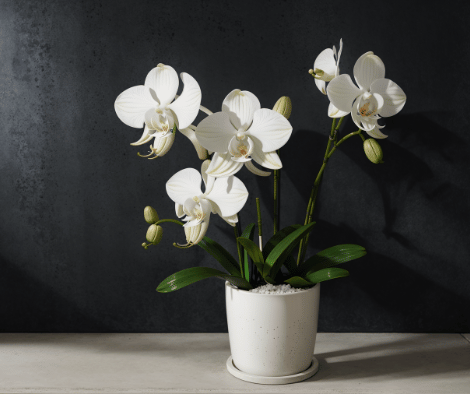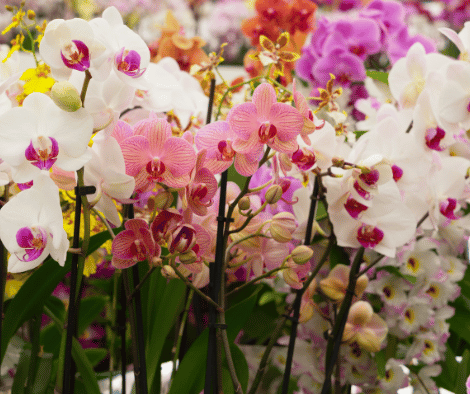Known as a beloved houseplant, Orchids (Orchidaceae) offer simplicity in cultivation and maintenance when their optimal growing conditions and care needs are met. Among the vast array of orchid species available, Phalaenopsis, Cattleya, Dendrobium, and Cymbidium emerge as popular choices for enthusiasts and beginners alike.
Here’s an overview of these enchanting blooms:
| Common Name | Orchid, moth orchid, corsage orchid, boat orchid |
| Botanical Name & Family | Orchidaceae |
| Plant Type | Perennial, Herbaceous |
| Mature Size | 1–3 ft. tall, 6–12 in. wide |
| Sun Light Exposure | Partial Shade to Full Sunlight |
| Soil Mix | Well-drained |
| Soil pH | Acidic |
| Flowering Time | Varies |
| Flower Color | Pink, purple, yellow, orange, green,white, red |
| Native | North America, South America, Central America, Europe, Asia, Africa, Australia, Caribbean |
What are Orchids?
Orchids belong to the Orchidaceae family, one of the largest plant families worldwide, comprising over 25,000 species and countless hybrids. Renowned for their intricate flowers and elegant foliage, orchids showcase a wide range of shapes, colors, and sizes, making them highly prized among plant enthusiasts.
With proper care, indoor potted orchids have the potential to thrive for an extended period, often spanning 15 to 20 years.
Orchids typically undergo a re-blooming cycle within six to nine months, although occasionally, it may take up to a year. Patience is key when awaiting orchid blooms, so ensure your orchid is in an environment conducive to its health and happiness to promote re-blooming.
To get an orchid to bloom again, you will need to prune the stem back and reduce the amount of fertilizer you are feeding it. Once a new leaf appears on the stem, you can resume your regular watering and fertilizing schedule.
When to Grow Orchids
- Orchids can be grown indoors or outdoors, depending on the species and climate.
- Many orchids thrive in temperate climates, while others require specific conditions found in tropical regions.
- Understanding the unique needs of each orchid species is essential for successful cultivation.
Orchid Flowering Season
- The flowering season varies depending on the orchid species and environmental factors.
- While some orchids bloom year-round, others have distinct flowering periods typically tied to specific seasons.
- Orchid enthusiasts eagerly await the spectacular blooms that adorn their plants during these flowering seasons.
Varieties Of Orchids
- Phalaenopsis Orchids: Also known as moth orchids, Phalaenopsis orchids are popular for their elegant, long-lasting blooms and ease of care.
- Cattleya Orchids: Known for their large, showy flowers and delightful fragrance, Cattleya orchids are favored by many orchid enthusiasts.
- Dendrobium Orchids: Dendrobium orchids encompass a diverse group of species with varying flower sizes, shapes, and colors, making them a versatile choice for growers.
- Cymbidium Orchids: With their stunning sprays of flowers in vibrant colors, Cymbidium orchids flowers are often used in floral arrangements and corsages.
- Oncidium Orchids: Often called dancing lady orchids due to the resemblance of their flowers to dancing figures, Oncidium orchids offer a wide range of colors and patterns.
- Miltonia Orchids: Miltonia orchids flowers , also known as pansy orchids, feature unique, pansy-like flowers and are cherished for their exquisite beauty.
- Vanda Orchids: Vanda orchids flowers are large, colorful and are prized for their stunning appearance and long-lasting blooms.
Back Bulb In Orchids
Back bulbs in orchids refer to older pseudo-bulbs or growths that have already bloomed and may no longer produce flowers. These bulbs store energy and nutrients for the plant and can serve as a source of new growth or propagation. Further we ‘ll see how to propagate orchids from back bulbs.
How to Propagate Orchids
Propagating orchids can be done through several methods, including division, back bulbs, keiki (baby plantlets), and tissue culture. Here’s a guide on how to propagate orchids using these methods:
- Division:
- Select a healthy orchid with multiple pseudo-bulbs or growth points.
- Carefully remove the orchid from its pot and gently separate the pseudo-bulbs or growth points, ensuring that each division has its own set of roots.
- Plant each division in its own pot with fresh orchid potting mix, ensuring that the pseudo-bulbs or growth points are positioned at the correct depth and the roots are covered with potting mix.
- Water the newly potted divisions thoroughly and provide the appropriate care to encourage root establishment and new growth.
- Back Bulbs:
- Identify mature back bulbs on the orchid that have the potential to produce new growth.
- Carefully remove the back bulbs from the orchid and plant them in small pots filled with orchid potting mix.
- Provide the same care as for mature orchids, including appropriate light, temperature, humidity, and watering, to encourage new growth from the back bulbs.
- Keiki (Baby Plantlets):
- Some orchid species, such as Phalaenopsis, produce keiki, or baby plantlets, along their flower spikes.
- Allow the keiki to develop roots and a few leaves before removing it from the parent plant.
- Plant the keiki in its own pot with orchid potting mix, ensuring that the roots are covered and the plant is secure.
- Provide the same care as for mature orchids to encourage the keiki to grow into a healthy adult plant.
- Tissue Culture:
- Tissue culture is a more advanced propagation method that involves growing orchids from small pieces of tissue in a laboratory setting.
- This method requires specialized equipment and expertise and is typically done by professional orchid growers or researchers.
Ways to Grow Orchids
Orchids can be grown in various settings, including pots, baskets, or mounted on tree branches or specialized mounts. Each method offers advantages and challenges, and selecting the appropriate growing method depends on the orchid species and grower’s preferences.

Care & Growth Tips for Orchids
- Light: Most orchids prefer bright, indirect light. Place them near a window where they can receive filtered sunlight, but avoid direct exposure to intense sunlight, which can cause leaf burn. Adjust the placement based on the orchid’s light requirements, as some varieties may tolerate lower light levels.
- Temperature: Orchids thrive in moderate temperatures, typically between 65°F to 80°F (18°C to 27°C) during the day and slightly cooler at night. Avoid exposing orchids to extreme temperature fluctuations, drafts, or cold air.
- Humidity: Orchids require humidity levels of around 50% to 70% for optimal growth. To increase humidity, place the orchids on a humidity tray filled with water and pebbles or use a room humidifier. Misting the leaves occasionally can also help maintain humidity levels.
- Watering: Water orchids thoroughly when the potting medium is dry to the touch, typically every 7 to 10 days. Allow excess water to drain away completely, as orchids are susceptible to root rot from standing water. Adjust the watering frequency based on environmental factors such as temperature, humidity, and potting medium.
- Potting Medium: Use a well-draining potting medium specifically formulated for orchids, such as orchid bark, sphagnum moss, or a combination of both. Repot orchids every 1 to 2 years or when the potting medium breaks down or becomes compacted.
- Fertilization: Feed orchids regularly with a balanced orchid fertilizer diluted to half or quarter strength. Apply fertilizer during the growing season, typically from spring to fall, and reduce or stop fertilization during the dormant period in winter.
- Air Circulation: Provide adequate air circulation around orchids to prevent fungal diseases and promote healthy growth. Avoid overcrowding plants and ensure good ventilation in the growing area.
- Pruning: Remove spent flowers and yellowing or dead leaves to promote new growth and maintain the orchid’s appearance. Use sterile tools to avoid introducing pathogens to the plant.
- Pest and Disease Control: Monitor orchids regularly for signs of pests such as aphids, mealybugs, or spider mites, and treat infestations promptly with insecticidal soap or neem oil. Prevent fungal and bacterial diseases by avoiding overwatering and maintaining proper air circulation.
How To Re-Pot Orchids
Re-potting an orchid is an essential aspect of orchid care that ensures its continued health and vitality. Here’s a step-by-step guide on how to repot an orchid:
- Choose the Right Time: Spring is generally the best time to repot orchids, as they are usually in an active growth phase after their winter rest.
- Gather Your Supplies: You’ll need a new pot or container, fresh orchid potting mix, and pruning shears or scissors.
- Prepare the Orchid: Carefully remove the orchid from its current pot by gently grasping the base of the plant and easing it out of the pot. If the roots are tightly packed, you may need to carefully loosen them with your fingers or a tool.
- Inspect the Roots: Take this opportunity to inspect the orchid’s roots. Trim away any dead, damaged, or rotting roots using sterile pruning shears. Healthy roots should be firm, green, or white.
- Choose the Right Pot: Select a new pot that is just slightly larger than the orchid’s root system. Orchids prefer snug pots, as this provides stability and prevents over-watering.
- Add Potting Mix: Place a layer of fresh orchid potting mix at the bottom of the new pot. Gently spread the orchid’s roots over the potting mix, ensuring they are evenly distributed.
- Fill in with Potting Mix: Carefully fill in the gaps around the roots with more potting mix, ensuring that the orchid is stable and upright in the pot.
- Watering: Once the orchid is re-potted, water it thoroughly to settle the potting mix and hydrate the roots. Allow any excess water to drain away completely.
- Aftercare: After re-potting, place the orchid in a location with appropriate light and temperature conditions. Avoid direct sunlight and extreme temperatures until the orchid has had time to adjust to its new pot.
- Monitor and Maintain: Keep an eye on your orchid in the days and weeks following re-potting, ensuring that it remains healthy and hydrated. Resume your regular orchid care routine once the plant has settled into its new pot.
Why Should You Grow Orchids?
Growing orchids offers numerous rewards, including the opportunity to cultivate breathtaking blooms, explore the fascinating diversity of orchid species, and engage in a fulfilling hobby that nurtures creativity and patience. Additionally, orchids contribute to indoor and outdoor environments with their beauty, elegance, and unique charm.
Whether you’re a seasoned orchid enthusiast or a beginner looking to embark on an exciting journey into orchid cultivation, these captivating plants are sure to captivate your heart and inspire your green thumb. Explore the world of orchids and discover the joy of growing these extraordinary flowers.
